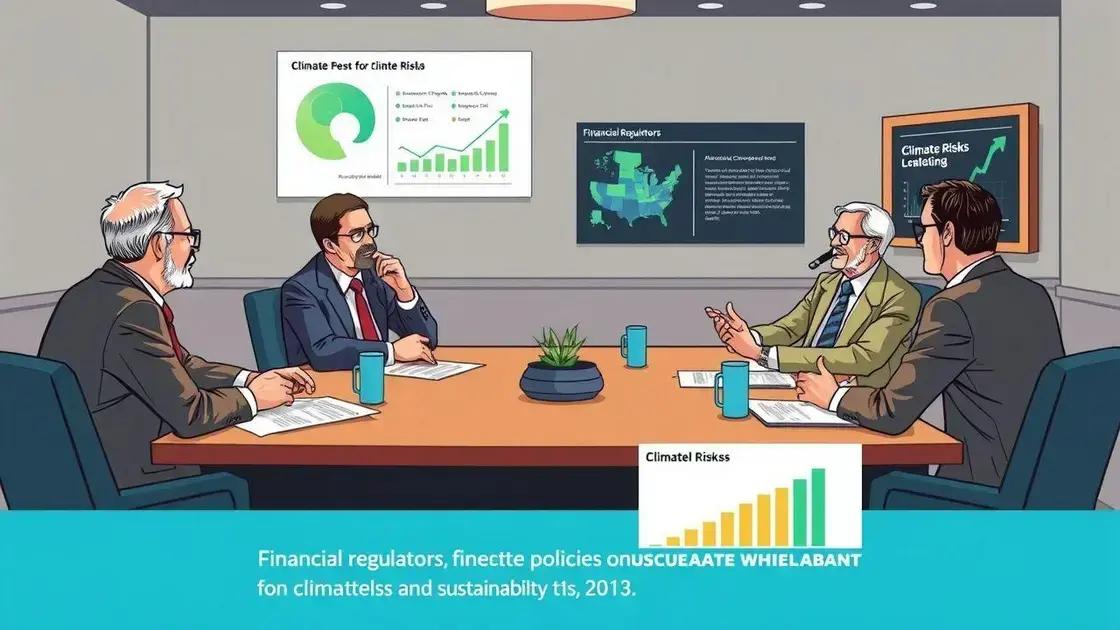Climate risk triggering next financial crisis: are you prepared?

Climate risk is increasingly recognized as a significant factor triggering the next financial crisis, driving the need for effective investment strategies and regulatory responses to protect the economy.
Climate risk triggering next financial crisis is not just a hypothetical scenario; it’s becoming a pressing reality for investors and businesses alike. Have you considered how your finances might be impacted by changing climate conditions?
Understanding climate risk and financial stability
Understanding the connection between climate risk and financial stability is essential in today’s changing environment. As extreme weather events become more frequent, their potential impacts on the economy are increasingly apparent.
What is climate risk?
Climate risk refers to the potential financial losses due to environmental factors. This includes physical risks from weather events and transition risks associated with shifting toward a greener economy. It’s crucial for businesses and investors to grasp these risks to safeguard their assets.
Types of climate risks
- Physical risks: Damage from floods, hurricanes, and wildfires can lead to significant economic losses.
- Transition risks: Companies may face financial challenges as regulations change, requiring investments in sustainable practices.
- Liability risks: Companies can be held accountable for environmental damage, leading to costly lawsuits.
For investors, understanding how these risks affect financial markets is vital. For instance, a sudden shift in weather patterns can destabilize commodity prices. This change can ripple through supply chains, affecting entire industries and, ultimately, portfolios.
How climate risks impact financial stability
When climate risk is factored into financial planning, it can influence lending, insurance, and investment decisions. Financial institutions are beginning to recognize the importance of assessing climate risks as part of their risk management processes.
The global economy could face instability if businesses and investors ignore these changes. Companies that fail to adapt may not only suffer financially but can also create wider market instability.
By integrating climate risk assessments into their strategies, firms can enhance resilience and contribute to overall economic stability. This proactive approach enables businesses to adjust their practices and investments in a way that accommodates future challenges.
The impact of extreme weather on markets

The impact of extreme weather on markets is becoming increasingly evident as climate change accelerates. Natural disasters not only disrupt daily life but also create ripples in the economy.
Direct effects on supply chains
Extreme weather events such as hurricanes, floods, and droughts can lead to significant disruptions in supply chains. These disruptions can create shortages of goods, which may drive prices up. Businesses that rely on timely deliveries and resources need to be particularly aware of these risks.
- Increased costs: Disrupted supply chains can lead to higher transportation and production costs.
- Market instability: Scarcity of products can cause price spikes, affecting overall market stability.
- Consumer behavior: Shifting consumer demand can result in athletes or companies losing revenue when they cannot provide goods.
Additionally, agriculture is vulnerable to the effects of changing weather patterns. This volatility in crop yields can affect food prices globally. When harvests fail due to drought or flooding, the consequences are felt across the market.
Insurance and financial services
Insurance companies also feel the impact of extreme weather. Increased claims from natural disasters lead to higher premiums and may even result in insurers exiting high-risk markets. This creates gaps in coverage and can deter investments in affected areas.
Furthermore, investors are becoming more cautious. As they assess their portfolios, they consider how climate risks can affect their assets. Public companies that fail to address these risks may see their stock prices decline as investors pull back.
In conclusion, the interconnectedness of extreme weather and markets highlights the need for proactive strategies. Businesses and investors must adapt to these challenges to minimize disruption and capitalize on opportunity amidst uncertainty.
Investing strategies in the face of climate uncertainty
Investing strategies in the face of climate uncertainty are becoming crucial for investors looking to protect their portfolios. As climate risks become more pronounced, adapting to these changes can lead to successful investments.
Focus on sustainable investments
One effective strategy is to invest in sustainable companies. These firms are committed to environmentally-friendly practices and are more likely to thrive amidst increasing regulatory pressures. By aligning investments with sustainability, investors can potentially benefit in the long term.
- Green energy: Companies focused on renewable energy sources are positioned to grow as fossil fuels decline.
- ESG criteria: Investing based on environmental, social, and governance (ESG) criteria can help identify accountable companies.
- Innovation: Targets that invest in technology aimed at mitigating climate change often see better returns.
Focusing on companies that prioritize sustainability not only helps in aligning with one’s values but also reduces the risks associated with climate change.
Diversification as a strategy
Diversifying investments is another vital strategy. Spreading investments across different sectors can mitigate risks posed by extreme weather events. For instance, investing in both technology and agriculture can create a buffer against market volatility.
Additionally, keeping a mix of global investments can help cushion against localized climate impacts. This approach allows investors to tap into regions that may not be as severely affected by climate change.
Investors should also consider adjusting their portfolios regularly. Staying informed about the latest climate research and market trends is essential in making timely adjustments. By being proactive, investors can capitalize on emerging opportunities while protecting against potential losses.
Regulatory responses to climate-related financial risks

Regulatory responses to climate-related financial risks are increasingly important as governments and financial institutions recognize the need for action. These regulations aim to protect investors and the economy from the financial impacts of climate change.
Key regulations shaping the landscape
Many countries are starting to implement regulations that require companies to disclose their climate risks. This transparency allows investors to make informed decisions about where to put their money. Regulatory frameworks are evolving to address these challenges directly.
- Disclosure requirements: Companies must report their exposure to climate risks, helping stakeholders gauge the financial implications.
- Carbon pricing: Some governments are introducing taxes on carbon emissions to incentivize businesses to lower their carbon footprints.
- Incentives for green investments: Tax credits and subsidies may support renewable energy projects, steering investments toward sustainable initiatives.
These regulations can influence investment patterns significantly. For instance, as more companies disclose their risks, investors might choose to divest from high-emission sectors. This shift can create a ripple effect, pushing more businesses to adopt sustainable practices.
The role of financial institutions
Financial institutions play a crucial role in regulatory responses. They are expected to integrate climate risk assessments into their risk management frameworks. This proactive approach helps them identify potential threats to their portfolios.
Moreover, banks and insurance companies are now considering climate risks when evaluating loan applications and underwriting policies. This change can greatly affect funding for fossil fuel projects, making it harder for them to secure financing.
As regulations tighten, organizations that fail to adapt may face reputational risks and legal challenges. On the other hand, those that embrace these changes can strengthen their brand and appeal to a growing market of sustainability-focused investors.
FAQ – Frequently Asked Questions about Climate Risk and Financial Stability
What are climate-related financial risks?
Climate-related financial risks refer to the potential losses that investors and businesses face due to the impacts of climate change, including extreme weather events and regulatory changes.
How can sustainable practices impact investments?
Sustainable practices can enhance a company’s reputation and market position, attracting more investors who are looking for environmentally responsible options.
What role do regulations play in financial markets?
Regulations require companies to disclose climate risks, promoting transparency that helps investors make informed decisions based on potential financial impacts.
How can investors protect themselves from climate risks?
Investors can diversify their portfolios, focus on sustainable investments, and keep abreast of regulatory changes to better manage the risks associated with climate change.





